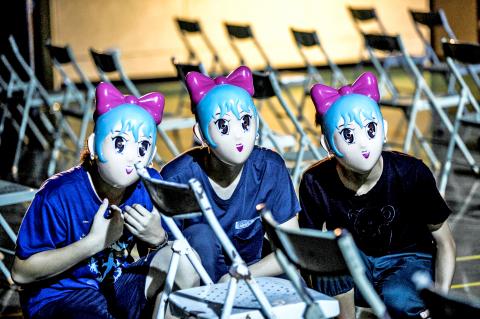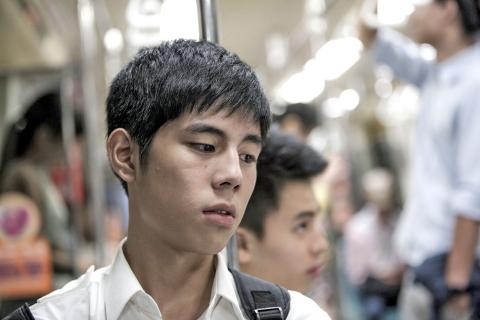At a time when the sound of teen film spells overuse and cliche, Yee Chih-yen’s (易智言) Meeting Dr. Sun (行動代號:孫中山) comes as a refreshing surprise. The comedy, about a group of teenage boys and their whimsical plans to address their poverty, casts a lyrical and vigorous look into Taiwan’s social inequality through the eyes of the young. Alternating between farcical humor and emotional acuteness, Yee’s latest work can be seen as an ode to the waves of youthful civil disobedience against the system, which climaxed in the Sunflower movement.
Lefty (Zhan Huai-yun, 詹懷雲), one of the central characters, lives with his grandmother who earns NT$15 for every plastic flower she makes at home. Lefty believes he is the poorest kid in his high school and is unable to pay the “class fee” extorted by a classmate. While hiding from the bully in the school storeroom one day, he discovers a bronze statue of Sun Yat-sen (孫逸仙). For Lefty, however, the statue doesn’t signify the ROC’s founding father, but a financial windfall in the form of scrap metal worth a big chunk of money. The slab, he thinks, will be his ticket out of poverty.
And so he immediately devises a plan to steal and sell the valuable statue, calling on his equally impecunious friends to help. However, he soon finds out that Sky (Wei Han-ting, 魏漢鼎), a boy who goes to the same school, is also plotting to turn the discard into quick cash.

Photo courtesy of Activator Marketing Company
The two hold a match to decide who is poorer and thus needs the money more. Using food tastings at supermarkets as the source of his daily diet and sleeping on the streets to avoid his drunken father’s violent outburst, Sky wins. Readily accepting his defeat, Lefty offers to collaborate with Sky, whom he thinks a new comrade.
Watching the enthusiastic Lefty sharing the details of his plan, Sky has something else in mind.
When the big night comes, two groups of masked thieves appear on campus. The battle over the statute of Sun Yat-sen ends up with Sky and Lefty lying on the empty street in Ximending (西門町), exhausted. As the wailing of police sirens comes near, they recognize the problem of poverty and fight it together.

Photo courtesy of Activator Marketing Company
In Meeting Dr. Sun, director Yee does a superb job in translating the anger against the unjust, corrupt system into an expressive comedy. The most noticeable example is the use of pantomime in the sequence in which the young burglars try to carry out their operation. What’s more striking is how the story finds its most resonant strength in juxtaposing the light with the unbearable. In the sequence in which the group of teenagers bicker over who comes from the most disadvantaged family, what starts out as fun raillery ends up with an indignant cry from Sky: “the children of our children are doomed to be poor.”
More fable than drama, the film approaches the complex social problems with lucid simplicity.
Equally essential to the narrative is the soundtrack composed by Chris Hou (侯志堅). Hou’s music is playful, delicate and vivacious at the same time, almost like a waltz of the humiliated and the insulted.
Towards the end of the film, we follow the bronze statue as it’s transported on a truck through the streets of Taipei. Suddenly, the camera pans up to show the gang of teenage boys, who raise their hands in solidarity, the Taipei World Trade Center towering in the background. It is a poignant moment, filled with poetry, and like the film itself, resonates long after the closing credits.

Dec. 16 to Dec. 22 Growing up in the 1930s, Huang Lin Yu-feng (黃林玉鳳) often used the “fragrance machine” at Ximen Market (西門市場) so that she could go shopping while smelling nice. The contraption, about the size of a photo booth, sprayed perfume for a coin or two and was one of the trendy bazaar’s cutting-edge features. Known today as the Red House (西門紅樓), the market also boasted the coldest fridges, and offered delivery service late into the night during peak summer hours. The most fashionable goods from Japan, Europe and the US were found here, and it buzzed with activity

US Indo-Pacific Commander Admiral Samuel Paparo, speaking at the Reagan Defense Forum last week, said the US is confident it can defeat the People’s Republic of China (PRC) in the Pacific, though its advantage is shrinking. Paparo warned that the PRC might launch a “war of necessity” even if it thinks it could not win, a wise observation. As I write, the PRC is carrying out naval and air exercises off its coast that are aimed at Taiwan and other nations threatened by PRC expansionism. A local defense official said that China’s military activity on Monday formed two “walls” east

The latest military exercises conducted by the People’s Liberation Army (PLA) last week did not follow the standard Chinese Communist Party (CCP) formula. The US and Taiwan also had different explanations for the war games. Previously the CCP would plan out their large-scale military exercises and wait for an opportunity to dupe the gullible into pinning the blame on someone else for “provoking” Beijing, the most famous being former house speaker Nancy Pelosi’s visit to Taiwan in August 2022. Those military exercises could not possibly have been organized in the short lead time that it was known she was coming.

The world has been getting hotter for decades but a sudden and extraordinary surge in heat has sent the climate deeper into uncharted territory — and scientists are still trying to figure out why. Over the past two years, temperature records have been repeatedly shattered by a streak so persistent and puzzling it has tested the best-available scientific predictions about how the climate functions. Scientists are unanimous that burning fossil fuels has largely driven long-term global warming, and that natural climate variability can also influence temperatures one year to the next. But they are still debating what might have contributed to this